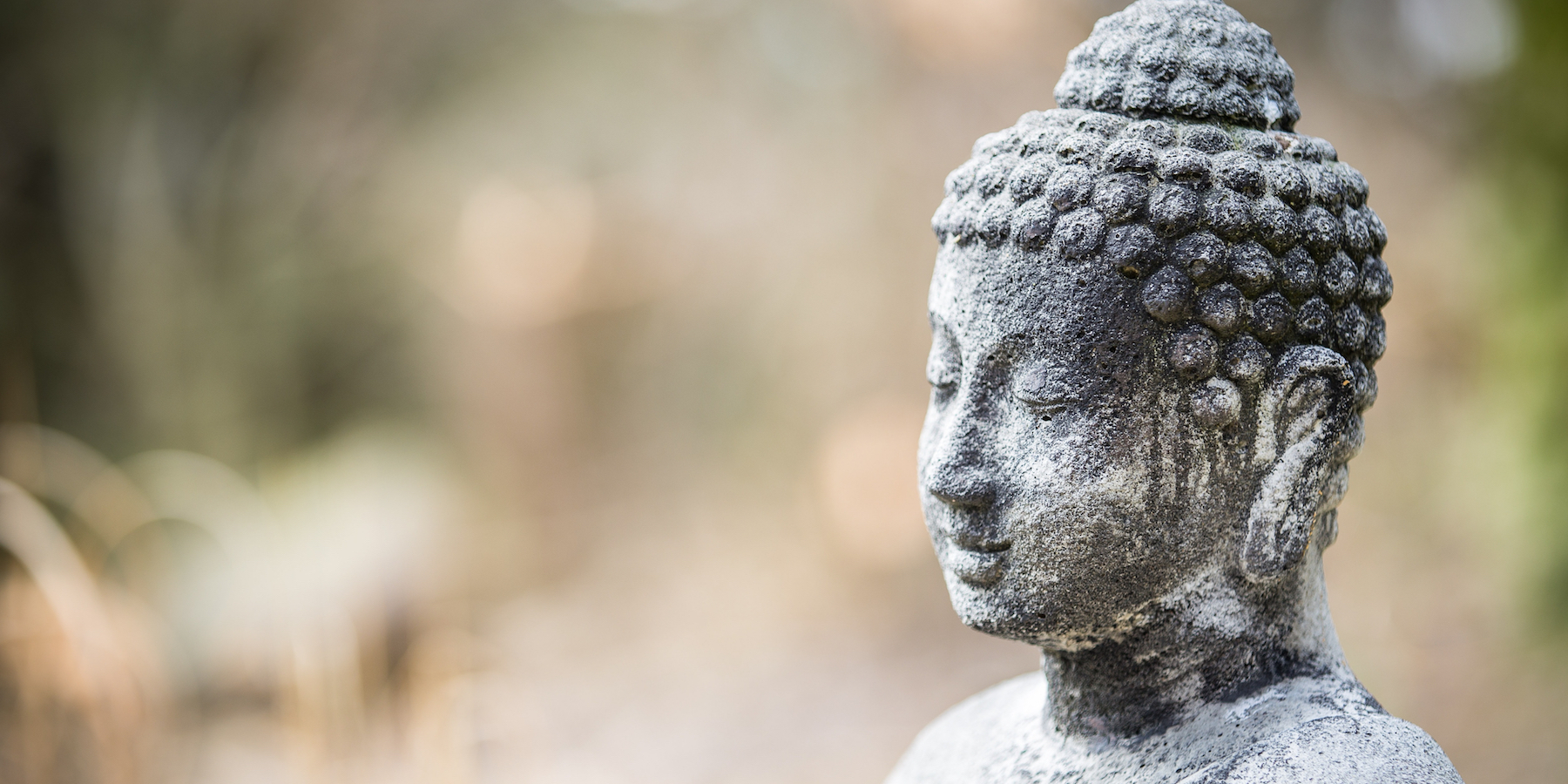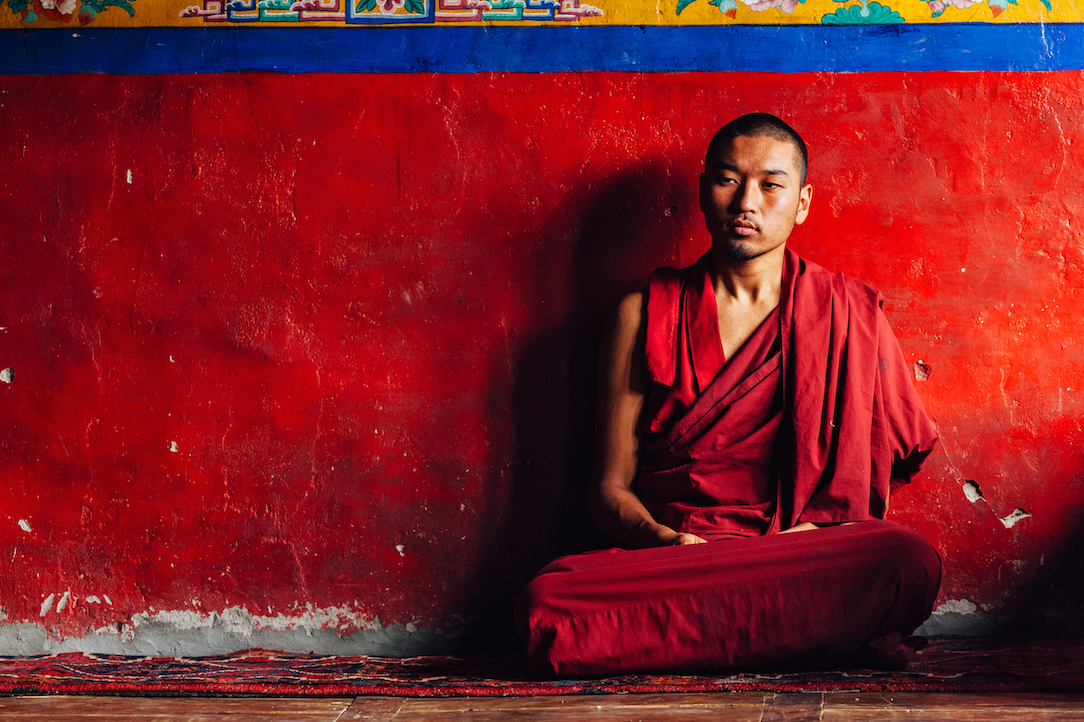A main feature of serenity meditation is the development of Samadhi, which refers to focused attention, gathered and placed on a single object. Another way to describe Samadhi is simply as concentration. The basic instructions for serenity meditation are to choose an object of attention, put aside distractions, focus and allow attention to become fully immersed or absorbed in that object. At its basic level the sequence involves firstly relaxing the body, then focussing attention and then paying attention to the vividness of an experience.
The Focus Of Attention In Serenity Meditation
In Theravada Buddhism there are many traditional objects to absorb into with serenity meditation practices. Some include the breath, the elements such as earth, water, and wind, various colours, peace and the qualities of the Buddha.
At refined levels the objects can include the experience of joy, tranquillity, contentment, equanimity, infinite space and nothingness. Technically, the four divine abodes (benevolence, compassion, appreciative joy and equanimity), are considered as serenity meditation practices because the meditator focuses solely on the experience and becomes absorbed into these qualities.
The Benefits Of Focused Attention
Focussing attention can calm the mind, relax the body and bring peace to the heart. It also has significant many mental health benefits, such as short-circuiting worry and rumination, increasing wellbeing and improving productivity. The principles of serenity meditation can be found in many psychotherapeutic strategies such as the development of the relaxation response (versus the stress response) (Benson, 1975), having flow experiences (Csikzentmihalyi, 1988) and as a way to induce trance states for hypnosis (Erikson and Rossi, 1979).
Though technically serenity meditations in Theravada Buddhism emphasise focussed attention and not physical manipulation, the soothing effect of slow and rhythmical breathing as used in many contemporary psychologies such as Compassion Focussed Therapy (CFT; Prof Paul Gilbert) could be an example of an overlap with contemporary psychological approaches.
Rhythmical breathing relaxes the body and calms the mind. Rhythmical breathing not only counters unhelpful over arousal such as panic or unwarranted aggressive anger, it also enables us to see and understand ourselves and our lives more clearly.
The Power Of The Concentrated, Serene Mind
The serenity aspect of meditation serves to provide power, focus and clarity to insight. Cultivating the power of a concentrated mind has been compared to shining a torch onto an object in the dark. Another comparison often used for developing serenity meditation is a telescope. Looking at the moon with unassisted eyes, we may not see much detail. However, with a powerful telescope, we can study the moon in great detail.
Serenity and the concentrated mind it develops give us the power of attention to see clearly and deeply into our body, mind (self) and life. With the increased mental clarity of a calm mind we are more able to understand what increases suffering and what reduces it and thereby also more able to act with wisdom and compassion.
Serenity And Mindfulness Meditation
Serenity meditation needs mindfulness to remember to stay on task. However, as mentioned above, the emphasis of serenity meditation is the cultivation of Samadhi (concentration).
Over a century ago, a founding father of modern psychology, William James said: “what we attend to becomes our reality”. This statement provides relevance to the practice of serenity meditation and the four divine abodes. When we attend to the nuances of a particular experience, our focus is enriched and enhanced and distractions from other experiences fall away. With focussed attention it is like we become more and more absorbed into the experience and it absorbs into us. With meditation on the four divine abodes as examples, it is as if we begin to embody and become the qualities we are focusing on.
The Compassionate Image Meditation
Professor Paul Gilbert, the creator of CFT, developed a compassionate image meditation. This practice has an overlap with aspects of serenity meditation in Theravada Buddhism and has some similarities to deity practices found in Mahayana Buddhism.
With this exercise one brings to mind a compassionate figure (person or other) with as much clarity as possible. One can focus on the figure’s smile or warm eyes or imagine hearing words of wisdom.
From a CFT perspective, these cues are evolutionary based stimulants for the affiliative (connection) soothing emotional system. From a Buddhist serenity meditation perspective, paying attention to these nuances helps to absorb into these qualities. Subjectively, it may feel like compassion is flowing from this figure into us. Later, practitioners realise that the compassion is coming from within their own hearts. Regardless of whether the experience of compassion feels as if it is flowing from other to self or self to self, it is being cultivated.
The Jhanas
Serenity meditation practiced at basic levels enhances wellbeing. Cultivated at highly refined levels, serenity meditation can result in profoundly healing shifts in consciousness, perception, wholesome pleasure and wellbeing. These refined levels of concentration are called jhanas. In Theravada Buddhist systems, the cultivation of five attention factors result in the jhanas. These five jhana factors are:
- initial application,
- sustained application,
- rapture or joy,
- happiness and
- one pointedness or unification of mind.
The 5 Jhana Factors
The first jhana factor is initial application. It is the mental factor of applying the mind to the object. It has the function of lifting the mind up and directing it to the object. It makes attention strike again and again at the object. The first factor is strongly influenced by conscious intention, and it could be considered as the same. Experientially, it requires right effort or diligence to keep it up.
The second jhana factor, sustained application, is the continuation of initial application as the mind is anchored on the object. Like a bell that is struck and resonates, initial application is the initial striking and sustained application is the resonance (Bodhi, 2006). Like a surfboard rider catching a wave, the effortful paddling is like the initial application and board being picked up by the wave is like sustained application. Another comparisons for the relationship between initial application and sustained application has included a bird flying, where the flapping of the wings are like initial application and sustained application is like the bird flying through the air (Gunaratana, 1985).
The third jhana factor is piti (Pali), which is also called rapture or joy. Joy involves a pleasurable interest in the object and is energetic. That is, it can feel as if energy is flowing through our bodies. Rapture can range from mild and fleeting pleasant experiences to being overwhelmed with ecstasy.
The fourth jhana factor is sukha (Pali), which translates as happiness. This pleasurable experience is more refined than piti and it is also more fulfilling satisfying, tranquil, serene and complete.
The fifth jhana factor is often called one-pointedness which is single-minded attention without distraction. With one-pointedness, the mind becomes completely absorbed in one object to the exclusion of everything else. Another way of describing this factor is unification of mind. According to Culadasa (2015, p.430) unification of mind means:
“The bringing together of a large number of diverse, independent, and unconscious mental processes or sub-minds in support of a consciously chosen intention.”
The Different Types Of Jhanas
Jhanas arise from the cultivation and co-arising of these factors. The jhanas are powerful levels of concentration that lead to increasingly sophisticated and altered states of consciousness and perception.
There are many different types of jhanas and classically eight different levels are described. The first four levels have a connection with bodily experiences and are called the jhanas of form. The more refined four levels successively called the 5th, 6th, 7th and 8th jhanas, have no connection with the body and are called formless jhanas.
The first jhana is characterised by joy, the second by happiness, the third by contentment (sukha with equanimity) and the fourth, equanimity.
A significant feature of the fifth (formless) jhana is the objective perception of infinite space, the sixth jhana is characterised by the perception of infinitely spacious consciousness, the seventh jhana is characterised by the experience of nothingness or empty space and the eight jhana by neither perception and non-perception.
Take this teaching on serenity meditation deeper and immerse yourself in one of Mal Huxter’s guided meditations and talks:
- Emulating The Jhanas For Joy, Happiness, Contentment And Equanimity Malcolm Huxter 33:41
- (Metta) Loving-Kindness As A Spacious And Divine Abode Malcolm Huxter 17:47
- Talk: Insight Meditation And The 4 Foundations Of Mindfulness Malcolm Huxter 57:40
- Mindfulness Of Breath At Three Places Malcolm Huxter 16:42
- Resting In Awareness Malcolm Huxter 15:20
The Buddha was highly skilled in the jhanas and could abide in the very refined and often highly blissful state of consciousness for extended periods of time. However, he realised that these states were subject to impermanence and therefore ultimately unsatisfactory. In order to realise Nirvana the Buddha developed penetrating and profound insight.
Read more: In this article, Buddhist teacher Scott Tusa explores the teachings of Buddha nature.
Serenity Meditation On The Pathway To Awakening
There are three basic pathways to awakening:
- the development of serenity first which is then followed by insight,
- insight practice without developing serenity, and
- the development of insight and serenity equally balanced and linked.
The traditional path is one where serenity meditation is taught before insight meditation, because the clarity and power of a concentrated and serene mind enhances insight. The path the Buddha followed for his enlightenment was serenity first, then insight.
The Buddha recommended that practitioners cultivate the jhanas up until the 4th jhana, as this level gives sufficient power of concentration to see into the nature of the mind, life and wake up to the four noble truths. Many meditation practitioners also developed the formless jhanas. Though significant achievements, these higher jhanas were not considered necessary to realise Nirvana. Furthermore, though the Buddha recommended developing the first four jhanas to provide a sufficient power of attention, it seems that this pathway (of serenity first) was also not completely necessary.
Read more about the buddha’s awakening.
In the suttas (records of the Buddha’s teachings) there are many occasions were practitioners realised Nirvana without following the path of serenity meditation. In these cases, practitioners would have sufficient momentary concentration to provide penetrative power of attention to realise the four noble truths. Therefore, in the process of waking up to the four noble truths, it is also possible to follow the path of what Buddhaghosa called “dry insight” in the Vissudhimagga.
Dry insight means that one does not first develop highly concentrated states of mind to give muscle to insight and the path to awakening is achieved with insight meditation alone. Even though what is called Insight meditation in the contemporary West is based on the principles of “dry insight”, many modern day meditation practitioners will often utilise both the serenity and insight approaches equally in their meditation practice and thus they are practicing along the path of serenity and insight linked together.
Read more: In another article, Mal Huxter explains the Buddha’s four noble truths and how to adapt the wisdom of dukkha to clinical psychology.








